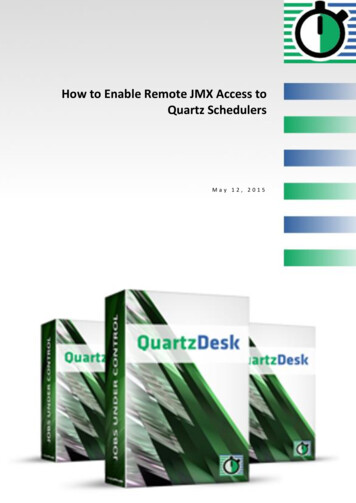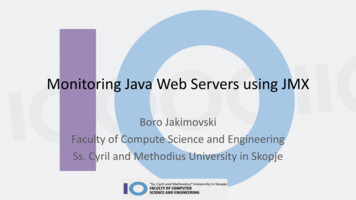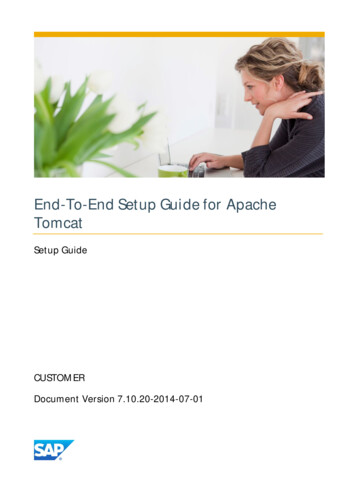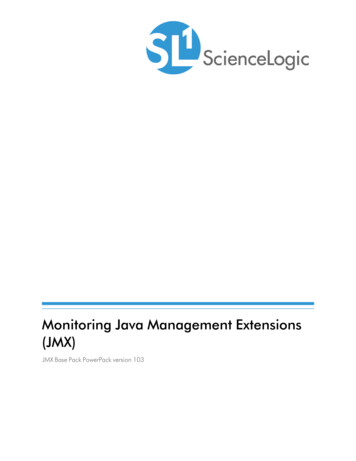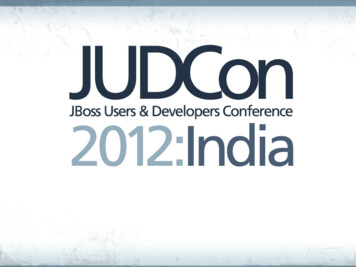
Transcription
Using JMX to Monitor Oracle Weblogic Partitions1. IntroductionIn this document a monitor is created using JMX. This monitor is made to show the performanceof a Data Source, which is deployed on a partition. Thus, MBeans are used not only to discovermanaged servers, but also to show partitions. In addition, as the main goal is to show the connectionpool’s runtime state (do not forget data sources belong to partitions) MBeans are also used todiscover the resource groups related to each partition. Furthermore, the program includes a classthat generates JDBC connection leaks to demonstrate how to monitor this kind of problems.In order to avoid any confusion related to matters such as partitions, MBeans, JMX and JDBC,some concepts are shown in the following section. After that, the code source of the program isexplained in detail to conclude with some screens of the GUI developed.2. Conceptsa. Java Management Extension (JMX). It is a framework that was created by Sun in orderto manage applications and devices. One of the main advantages of JMX is its capacity ofgoing through different layers of an architecture without modifying the original code. Withthis in mind, JMX does not have problems to work on different operating systems andnetworking protocols (Jiang, H. et al., 2010). This definition given by Jiang, H et al. (2010)makes sense since JMX is developed on Java so it leverages the language portability.b. MBean. The previous point states that JMX is a framework to administer applications anddevices. Thus, it is necessary a component, which exposes the properties and states ofapplications, devices and in this case application servers. This component is called MBeanand in addition, it allows the reconfiguration of application server’s properties (MazanattiN. et al., 2013)c. Domain. A domain is a logical structure that includes machines, servers, clusters,resources, etc. It means a domain includes every component from a Weblogic Server.According to Schildmeijer, M (2011) a domain is the most important administrative unitand at least has an Administration Server.d. Partition. This is one of the new concepts introduced by Oracle in Weblogic 12.2.1 as partof the multitenant architecture. A partition is a kind of micro container that allows splittinga domain into several independent parts called partitions. Of course, a partition is only apart from the new architecture, which includes other matters such as virtual targets,resource groups, etc. According to Oracle (2016) as cited by Castillo R. (2016) “ apartition is an administrative and runtime unit that is equivalent to a portion of a domain,which is used to run applications and their resources.”
e. Virtual targets. A virtual target defines two important things, a target pointed by resourcegroups at the partition or domain level and a HTTP server used by each target (Oracle,2016) as cited by Castillo R. (2016).f. Resource group. A resource group is a logical way to organize resources and applicationsaccording to their use, environment or any criteria defined by a business. For example, itis possible to organize environments such as development and testing using resourcegroups to isolate applications and resources. If you have several modules such as orders,financial risk, fulfilments and so on, resource groups allows you to organize applicationsand resources that before were scattered.g. Data source and connection pools. Data sources are interfaces between applications anddatabases that allow developers to forget about database’s technical details. Data sourcesare implemented using Java Database Connectivity (JDBC) and defines a dynamic set ofconnections to the database. In addition, data sources are used by applications through JavaNaming and Directory Interface (JNDI) (Schildmeijer, M, 2011).Connection pools are sets of connections to the database that could be increased anddecreased dynamically. Since connecting applications with the database is an expensiveoperation, connection pools represents an advantage because they can be reused avoidingthe connections creation on demand (Schildmeijer, M, 2011).h. JDBC connection leaks. After a connection from the connection pool is used by anapplication, this connection (logical connection) is closed and then the connection (thephysical one) is returned to the connection pool to be reused. However, when an applicationdoes not implement the close method properly, physical connections are not released. Thus,over the time the connection pool will not have physical connections to manage theapplications demands. This problem is known as JDBC connection leak and could causethe crash of managed servers (Castillo, R., 2015). Therefore, giving ways to monitor thisproblem is a relevant matter.i. Topology used, the topology used in this post is depicted by figure 1.
Figure 1. Source: Castillo, R (2016)3. Source code explanationThe program developed in this post establishes a connection with the Weblogic server domainto show severs, partitions and data sources that belong to those partitions. In addition, datasources detected are used to generate a JDBC connection leak. This is the GUI used in thisdemonstration.
Figure 2. GUI created for this demonstrationThe GUI shown in figure 2 shows three sections Connection information. In this section parameters used to connect to the Weblogicserver such as protocol, URL, port, user and password are given by the user. Afterclicking the “Connect” button, the “Leak Generation” section is filled. Leak Generation. This section allows users to select severs partitions and the datasource that belongs to this combination of servers and partitions. In addition, here it ispossible to set the number of connection leaks user wants to generate. Monitoring. Using the button “Refresh” it is possible to monitor the main indicatorsthat belong to the data source under investigation. For example, in figure 2 it is possibleto see the state of data source “jdbc/Apex” is equal to Running.
Following each class is explained.Class JMXConnection Definition: Class used to establish the connection with the weblogic domain. Constructor: This class has a constructor that receives and initializes all the connectionparameters needed to establish a connection with the Weblogic domain. Methods public MBeanServerConnection getConnection()This method establishes the connection with the Weblogic domain and returnsan MBeanServerConnection object that is used during the program executionto access to Weblogic servers (Administrator and managed servers) and otherresources.
It is important to remark that in this case the ntime” is used. It is the sameas using this command on WLST.Class ServerMonitoring Definition: Class used to get the list of servers (Admin and managed) in a domain.The MBean defined by this string:"com.bea:Name DomainRuntimeService,Type ainRuntimeServiceMBean"Could be also analysed using WLST as is shown in this picture. Methods tionconnection)This method receives the connection object in order to get the list of server. Todo this, the method used the MBean defined by the concatenation of variablescalled combea and service.
Class PartitionMonitoring Definition: Class used to get the list of partitions related to a server. Methods Public ObjectName [] getListPartition (String serverName,MBeanServerConnection connection)This method receives the server name and returns the list of partitions,which belong to the server.This is the MBean used opened from WLSTClass JDBCMonitoring Definition: Class used to get the list of data sources per server and partition and toshow the main runtime indicators that belong to the data source.
Methods onnection, ObjectName dataSourceName)This method receives the connection object and the data source name to read itsruntime indicators. ction connection)serverName,This method receives the server name and the connection to the Weblogicserver to get the list of data sources that belong to the domain.This is the MBean used opened from WLST.
public ObjectName [] getListDS(String serverName,partitionName, MBeanServerConnection connection)StringThis method receives the server name, the partition name and the connection tothe Weblogic server to get the list of data sources that belong to the partition.This is the MBean used opened from WLST public String getJNDINames(String dataSourceName, StringdomainName, MBeanServerConnection connection)As this program is also used to generate JDBC connection leaks, it isnecessary to know the JNDI name associated to each data source inorder to get a connection. This method gets the JNDI name based onthe data source name, the domain name and the connection object. Ofcourse, the user does not need to enter the domain name.
This is the MBean used opened from WLST public String getJNDINames(String dataSourceName, StringdomainName, String partitionName, MBeanServerConnectionconnection)This method gets the JNDI name based on the data source name, thedomain name, the partition name and the connection object. Of course,the user does not need to enter the domain name.This is the MBean used opened from WLSTClass DBConnection Definition: Class used to generate JDBC connection leaks on a data source that isreceived as a parameter.
Constructor: The constructor receives the provider’s URL to establish the connectionwith the database. In the case of partitions the provider’s URL has this PartitionDevelopment Methods public void establishConnection(String dataSourceName)This method receives the dataSourceName and stablishes theconnection against the database. Connections are not closed onpurpose to generate the JDBC connection leak.4. DemonstrationIn this demonstration, the application is used to generate JDBC connection leaks on theWeblogic partition. First, the connection pool configuration is detailed.The initial capacity, maximum capacity and minimum capacity of data source calledjdbc/Apex is set on 20.
The property remove infected connection is disabled. Currently it is enabled by default.The parameter Inactive Connection Timeout is set on 30s. It is too short, but it is useful for ademonstration.Now it is time to execute the program.Figure 3As can be seen in figure 3 even though 30 connections were used and the capacity of the datasource is equal to 20, there are 15 busy connections and 5 available connections so the questionis why? It happens because the provider URL used to connect to the database includes thepartition information, i.e. onDevelopment
and the partition uses a virtual target that is deployed on a cluster. Thus, the connections arebalanced between two servers (15 connections per server) that are part of the cluster.In addition, figure 4 shows the connections were released after 30 seconds to prevent theconnection leak.Figure 4However, there is a problem because the number of connections leaks detected by ourprograms was not updated as is shown in figure 6.Figure 6Does the program have a problem? It seems to be the answer is not because even though thelog file shows the server has had released connections, the administrative console does notshow any evidence about the number of leak connections as can be seen in figure 7.Figure 7
Conclusions. This post has shown how to connect to the Weblogic server using some Javaclasses. It is important to remark that this demonstration could be used as a base to generatemore classes in order to monitor more server’s components. It would be interesting forcustomers who do not have any kind of monitoring system at the application server level. Whatis more, partitions were used demonstrating that using JMX on partitions is a simple process.Last but not least, it seems to be there is a problem with the MBean that shows the informationabout connection leaks because it did not work as is expected.5. References listJiang, H, Hai, L, Wang, N, & Di, R 2010, 'A performance monitoring solution for distributedapplication system based on JMX', Proceedings - 9Th International Conference On Grid AndCloud Computing, GCC 2010, Proceedings - 9th International Conference on Grid and CloudComputing, GCC 2010, p. 124-127, Scopus , EBSCOhost, viewed 18 February 2016.Mazanatti Nunes, William Markito Oliveira, Fabio. Getting Started with Oracle WebLogicServer 12c: Developer’s Guide. Birmingham, GBR: Packt Publishing Ltd, 2013. ProQuestebrary. Web. 18 February 2016.Schildmeijer, M 2011, Oracle Weblogic Server 11G PS2 Administration Essentials.[Electronic Book] : Install, Configure, Deploy, And Administer Java EE Applications WithOracle Weblogic Server, n.p.: Birmingham, UK : Packt Pub., 2011., University of LiverpoolCatalogue, EBSCOhost, viewed 19 February 2016.Castillo R. (2016) Weblogic Multitenant [Online document] Available /a/service/Multitenant/ (Accessed: 19 February2016)Castillo R. (2015) JDBC Connection leaks – Generation and Detection [BEA-001153][Online document] Available from: http://blog.sysco.no/db/locking/jdbc-leak/ (Accessed: 19February 2016)
makes sense since JMX is developed on Java so it leverages the language portability. b. MBean. The previous point states that JMX is a framework to administer applications and devices. Thus, it is necessary a component, which exposes the properties and states of applications, devices and in this case application servers. This component is .
